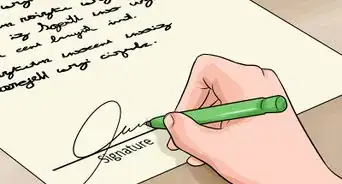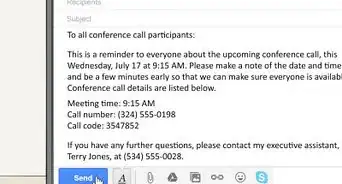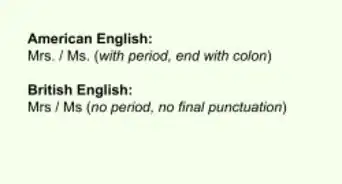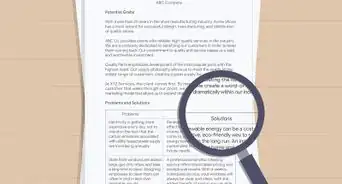This article was co-authored by Michael R. Lewis. Michael R. Lewis is a retired corporate executive, entrepreneur, and investment advisor in Texas. He has over 40 years of experience in business and finance, including as a Vice President for Blue Cross Blue Shield of Texas. He has a BBA in Industrial Management from the University of Texas at Austin.
This article has been viewed 140,697 times.
Having the skills to do a job doesn't always mean you have the knowledge to be able to effectively pursue the project or convince the client that you are the best choice. It is therefore essential to you success that you learn how to write an effective bid. There are several variables that need consideration when making a bid for any kind of project, whether it is for a construction job or consulting work for a company's marketing plan. One must consider equipment and supplies required, time spent working on the job, and any expenses that will be incurred in order to put together a realistic bid.
Steps
Researching Job Requirements
-
1Ask your client for references. You need to know up front if the potential client is a good credit risk and whether you ought to request payment up front. If you discover that the client has a record of not paying his bills, do not bid the job. It will only be a waste of time.
-
2Determine what type of work the job will require. Examine the working conditions or space. Analyze the difficulty of the work. Some jobs are not worth the time it takes to write a bid if the work is so difficult or time-consuming it won't allow you to make a profit.
- Try to determine your chances of being the winning bidder. If you know that another contractor or company that consistently underbids just to win a job is bidding, strongly consider whether or not you want to spend the time writing up the bid.
Advertisement -
3Ask the potential client about all aspects of the job. Find out the details about expectations and what the final product should reflect. If applicable, review the current condition of anything you'll be working on. For instance, if you're repairing a porch, check its condition before writing up the bid. If you're consulting with a company about its marketing campaign, request its current branding and positioning statement.
- Physical inspection of site is always wise when bidding any job.
-
4Check for bid requirements. Some companies might prepare a Request for Proposal (RFP) which details requirements and conditions for job and bid process. In such cases, the requirements should be followed exactly. These are especially prevalent for government contracts.
Calculating Potential Costs
-
1Calculate the costs for all supplies and expenses. Once you determine what the job entails, add up all the supplies needed, other expenses, labor costs and the amount of time you expect to spend on the job. Supplies include any materials needed to do the job. Expenses are any travel, lodging or meal costs, as well as subcontractor or equipment rental fees.
- Some companies may require minimum pay for labor or the use of minority contractors for a portion of the work.
- For example, if you are preparing a bid to install new windows you would include the cost of the windows, wood for the frames if required, and the number of workers needed to complete the job with their per day cost. Subcontractor costs might entail hiring a carpenter if extensive repair work is required for the window frames. Include how many days it will require to complete the job.
-
2Review all information. If you notice that you have missed anything, add it now. Check to make sure you are making a profit from the job and that all expenses, including any overhead costs, are calculated into the bid.
- Overhead refers to business expenses that are not related to direct materials or labor. Overhead expenses must be paid no matter what the volume of your business is. These can include insurance, rent and utilities. Overhead must be built into any bid or you risk not making a profit on the job.[1]
- For the new windows bid you might need to include a portion of the salary of an administrative assistant, rent or mortgage for office space, worker's compensation insurance and cost of utilities. Usually, these expenses are built into the retail price of the windows rather than itemized separately. Just don't forget to include them when you are preparing your bid.
- In addition, you should always add a contingency budget equal to 5%-10% of the total estimated cost.
-
3Write your bid proposal. All cost information should be in line-item form so that your client knows exactly what the bid includes. Specify any limitations, exclusions or stipulations for the bid, like limiting hours of work, specific safety requirements, etc. Your contact information, company name and payment requirements should appear prominently on the bid proposal. Include a list of references with contact information in your bid.
- Your bid could look something like this:
- Windows in A Day, Inc. 400 South St, Pittsfield, MA 800-222-5512
- Remove and dispose of 20 current windows at 100 Main St, Anytown, MA.
- Install 20 windows, part number WI2379, $250 per window = $5,000
- Repair all rotted wood along the window frames, $100 per window
- Existing windows become property of Windows in A Day and will be disposed of upon job completion.
- Prices include 3 laborers for 3 days
- Work is guaranteed for 10 years. We are fully insured with certificates available for inspection.
- Payment is due one week from the completion of the job. A 1% service fee will be added for every week beyond the payment due date.
- References: John Smith, 800-225-7980 or Edward Lang, 888-253-4367
- Your bid could look something like this:
-
4Print and submit your bid proposal. This should be printed on company stationery with your logo or type in your company name and address on plain white paper. Your bid should look professional and be accurate. Proofread it several times before printing the final copies. Present your potential client with two copies and keep one for your file.
- Re-read the business's RFP if one was provided. Check to see that your bid meets the requested formatting and submission requirements.
- Make sure you submit the bid before the deadline. It would be a shame to go through all the preparation and then lose the bid because you were late in submitting. If possible, obtain a receipt from the potential client stating the date your bid was received.
Increasing Your Chances of Success
-
1Ask former clients to recommend you. Perhaps a former client was very pleased with your work and would be willing to make a call to the decision maker for your current bid. You could also ask a former client to post a review on such online sites as Angie's List.[2]
- Your bid should include these references, particularly if they are for similar work.
-
2Follow all directions and requirements. If you are writing a bid proposal in response to a Request for Proposal, be sure to answer all questions and content requirements set forth in the document. In addition to references, most proposals include an executive summary, a documented explanation of work entailed in the bid proposal and other contractual information that makes it more specific than just a bid.[3]
- For example, your executive summary for the windows project could state "Windows in a Day, Inc. has been selling and installing top quality windows in both commercial and residential properties for the past 20 years. All work is guaranteed to last for 10 years."
- The work section could state "Install 20 windows, part number WI2379, at 100 Main St, Anytown, MA. Remove and dispose of current windows. Repair all rotted wood along the window frames."
-
3Analyze successes and failures. Keep track of bids that were won in the past and look for trends. Perhaps you won more with small vs. large businesses, the bid amounts were relatively small, or they were long vs. short term projects. Also find out who you are losing to and the reasons why.[4]
References
- ↑ http://www.investopedia.com/terms/o/overhead.asp
- ↑ http://www.angieslist.com/?gclid=Cj0KEQiAsNyxBRDBuKrMhsbt3vwBEiQAdRgPsk1OrYuEPGSUrppfMyvNZoAMlgE3Qhxg1pMQ5j8DWZUaAouO8P8HAQ&CID=PPC-Google-Join-Brand-NonMem-BrandNonMem-BrandMisspellings-All&s_kwcid=AL!3718!3!89985715841!e!!g!!www.angieslist.com&ef_id=VONgtQAAAaZgfSFe:20151102144905:s
- ↑ https://www.findrfp.com/Government-Contracting/How-to-Write-Proposal.aspx
- ↑ http://enewsletters.constructionexec.com/managingyourbusiness/2015/07/four-ways-to-increase-chances-of-winning-the-bid/
About This Article
Before writing a bid, calculate the costs for all supplies and expenses involved with the job, such as time spent on the job, travel, lodging, meals, and subcontractors. When writing the bid, place all cost information in line-item form so the client knows exactly what the bid includes. Also, make sure to include any limitations or stipulations, such as specific safety requirements. Finally, list your contact information, company name, payment requirements, and a list of references. To learn how to increase your chances of success, keep reading!









































































